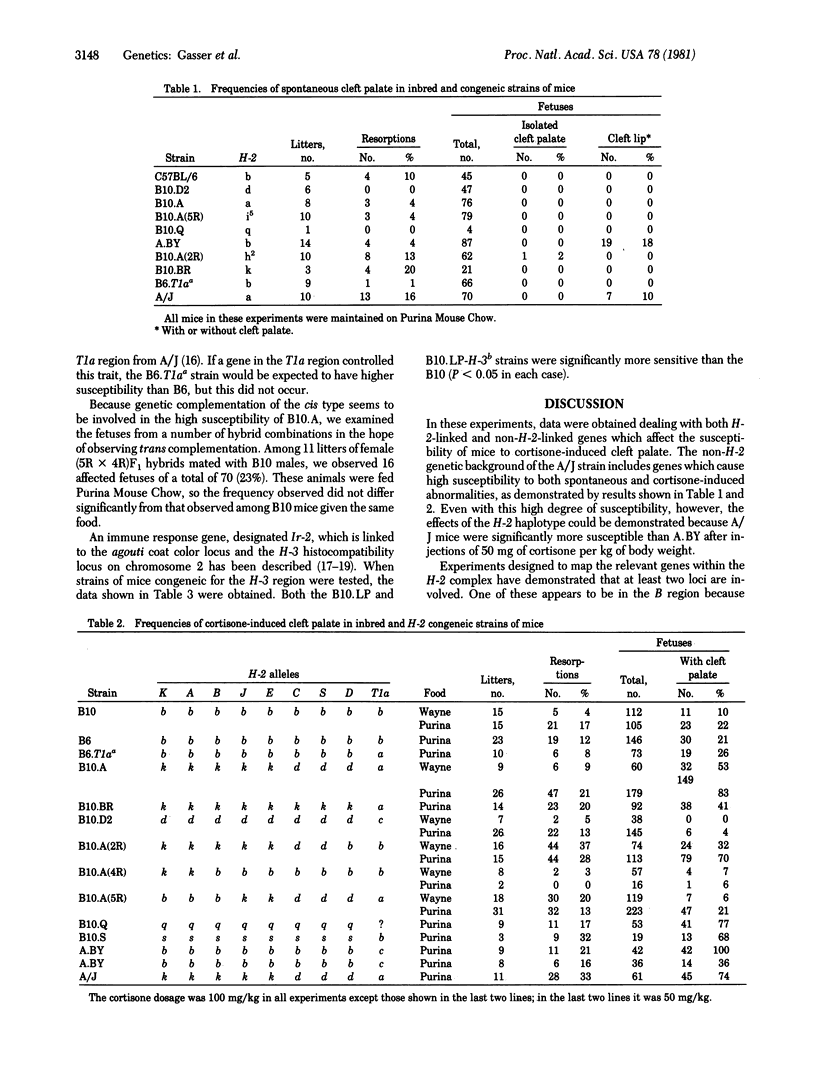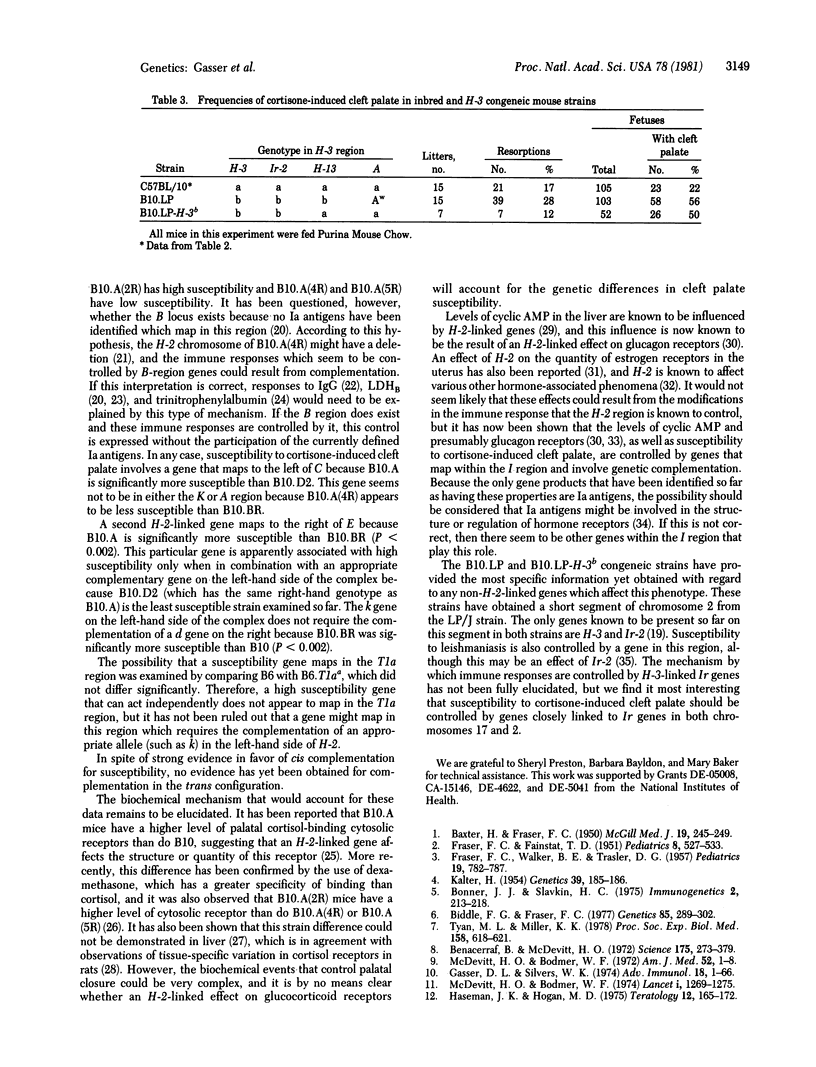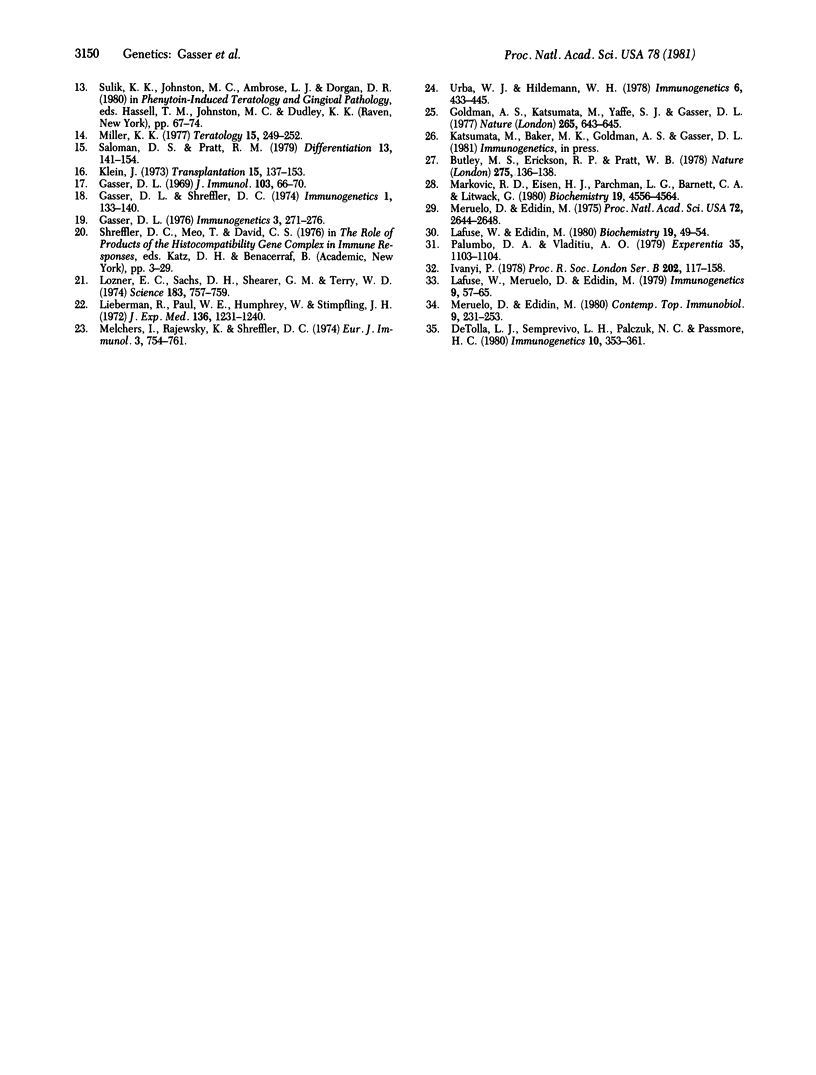Abstract
Inbred and congeneic strains of mice have been examined for susceptibility to cortisone-induced cleft palate, and the role of genes linked to H-2 on chromosome 17 has been confirmed. Increasing degrees of susceptibility were associated with the H-2d, H-2b, H-2k, and H-2a haplotypes, respectively, with H-2q and H-2s also being associated with fairly high levels of susceptibility. Evidence was obtained that suggests that one gene maps within the B region of H-2, and that a second H-2 linked gene which acts by complementation maps to the right of E. Another gene affecting this trait is closely linked to the H-3 and Ir-2 loci on the second chromosome.
Full text
PDF



Selected References
These references are in PubMed. This may not be the complete list of references from this article.
- BAXTER H., FRASER F. C. The production of congenital defects in the offspring of female mice treated with cortisone. A preliminary report. McGill Med J. 1950 Dec;19(4):245–249. [PubMed] [Google Scholar]
- Benacerraf B., McDevitt H. O. Histocompatibility-linked immune response genes. Science. 1972 Jan 21;175(4019):273–279. doi: 10.1126/science.175.4019.273. [DOI] [PubMed] [Google Scholar]
- Biddle F. G., Fraser R. C. Cortisone-induced cleft palate in the mouse. A search for the genetic control of the embryonic response trait. Genetics. 1977 Feb;85(2):289–302. doi: 10.1093/genetics/85.2.289. [DOI] [PMC free article] [PubMed] [Google Scholar]
- Butley M. S., Erickson R. P., Pratt W. B. Hepatic glucocorticoid receptors and the H-2 locus. Nature. 1978 Sep 14;275(5676):136–138. doi: 10.1038/275136a0. [DOI] [PubMed] [Google Scholar]
- FRASER F. C., FAINSTAT T. D. Production of congenital defects in the off-spring of pregnant mice treated with cortisone; progress report. Pediatrics. 1951 Oct;8(4):527–533. [PubMed] [Google Scholar]
- FRASER F. C., WALKER B. E., TRASLER D. G. Experimental production of congenital cleft palate: genetic and environmental factors. Pediatrics. 1957 Apr;19(4 Pt 2):782–787. [PubMed] [Google Scholar]
- Gasser D. L. Genetic control of the immune response in mice. I. Segregation data and localization to the fifth linkage group of a gene affecting antibody production. J Immunol. 1969 Jul;103(1):66–70. [PubMed] [Google Scholar]
- Gasser D. L., Silvers W. K. Genetic determinants of immunological responsiveness. Adv Immunol. 1974;18:1–66. doi: 10.1016/s0065-2776(08)60307-7. [DOI] [PubMed] [Google Scholar]
- Goldman A. S., Katsumata M., Yaffe S. J., Gassner D. L. Palatal cytosol cortisol-binding protein associated with cleft palate susceptibility and H-2 genotype. Nature. 1977 Feb 17;265(5595):643–645. doi: 10.1038/265643a0. [DOI] [PubMed] [Google Scholar]
- Haseman J. K., Hogan M. D. Selection of the experimental unit in teratology studies. Teratology. 1975 Oct;12(2):165–171. doi: 10.1002/tera.1420120209. [DOI] [PubMed] [Google Scholar]
- Iványi P. Some aspects of the H-2 system, the major histocompatibility system in the mouse. Proc R Soc Lond B Biol Sci. 1978 Jun 5;202(1146):117–158. doi: 10.1098/rspb.1978.0060. [DOI] [PubMed] [Google Scholar]
- Kalter H. The Inheritance of Susceptibility to the Teratogenic Action of Cortisone in Mice. Genetics. 1954 Mar;39(2):185–196. doi: 10.1093/genetics/39.2.185. [DOI] [PMC free article] [PubMed] [Google Scholar]
- Klein J. List of congenic lines of mice. I. Lines with differences at alloantigen loci. Transplantation. 1973 Jan;15(1):137–153. doi: 10.1097/00007890-197301000-00021. [DOI] [PubMed] [Google Scholar]
- Lafuse W., Edidin M. Influence of the mouse major histocompatibility complex, H-2, on liver adenylate cyclase activity and on glucagon binding to liver cell membranes. Biochemistry. 1980 Jan 8;19(1):49–54. doi: 10.1021/bi00542a008. [DOI] [PubMed] [Google Scholar]
- Lieberman R., Paul W. E., Humphrey W., Jr, Stimpfling J. H. H-2-linked immune response (Ir) genes. Independent loci for Ir-IgG and Ir-IgA genes. J Exp Med. 1972 Nov 1;136(5):1231–1240. doi: 10.1084/jem.136.5.1231. [DOI] [PMC free article] [PubMed] [Google Scholar]
- Lozner E. C., Sachs D. H., Shearer G. M., Terry W. D. B-cell alloantigens determined by the H-2 linked Ir region are associated with mixed lymphocyte culture stimulation. Science. 1974 Feb 22;183(4126):757–759. doi: 10.1126/science.183.4126.757. [DOI] [PubMed] [Google Scholar]
- Marković R. D., Eisen H. J., Parchman L. G., Barnett C. A., Litwack G. Evidence for a physiological role of corticosteroid binder IB. Biochemistry. 1980 Sep 30;19(20):4556–4564. doi: 10.1021/bi00561a003. [DOI] [PubMed] [Google Scholar]
- McDevitt H. O., Bodmer W. F. HL-A, immune-response genes, and disease. Lancet. 1974 Jun 22;1(7869):1269–1275. doi: 10.1016/s0140-6736(74)90021-x. [DOI] [PubMed] [Google Scholar]
- McDevitt H. O., Bodmer W. F. Protein clinical manifestations of primary tumors of the heart. Am J Med. 1972 Jan;52(1):1–8. doi: 10.1016/0002-9343(72)90002-2. [DOI] [PubMed] [Google Scholar]
- Melchers I., Rajewsky K., Shreffler D. C. Ir-LDHB: map position and functional analysis. Eur J Immunol. 1973 Dec;3(12):754–761. doi: 10.1002/eji.1830031204. [DOI] [PubMed] [Google Scholar]
- Meruelo D., Edidin M. Association of mouse liver adenosine 3':5'-cyclic monophosphate (cyclic AMP) levels with histocompatibility-2 genotype. Proc Natl Acad Sci U S A. 1975 Jul;72(7):2644–2648. doi: 10.1073/pnas.72.7.2644. [DOI] [PMC free article] [PubMed] [Google Scholar]
- Meruelo D., Edidin M. The biological function of the major histocompatibility complex: hypotheses. Contemp Top Immunobiol. 1980;9:231–253. doi: 10.1007/978-1-4615-9131-3_9. [DOI] [PubMed] [Google Scholar]
- Miller K. K. Commercial dietary influences on the frequency of cortisone-induced cleft palate in C57B1/6J mice. Teratology. 1977 Jun;15(3):249–251. doi: 10.1002/tera.1420150306. [DOI] [PubMed] [Google Scholar]
- Palumbo D. A., Vladutiu A. O. Estrogen receptor in uteri of mice of different H-2 genotypes. Experientia. 1979 Aug 15;35(8):1103–1104. doi: 10.1007/BF01949969. [DOI] [PubMed] [Google Scholar]
- Salomon D. S., Pratt R. M. Involvement of glucocorticoids in the development of the secondary palate. Differentiation. 1979;13(3):141–154. doi: 10.1111/j.1432-0436.1979.tb01577.x. [DOI] [PubMed] [Google Scholar]
- Tyan M. L., Miller K. K. Genetic and environmental factors in cortisone induced cleft palate. Proc Soc Exp Biol Med. 1978 Sep;158(4):618–621. doi: 10.3181/00379727-158-40259. [DOI] [PubMed] [Google Scholar]


